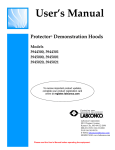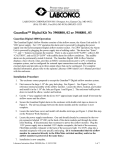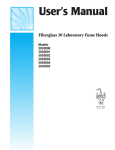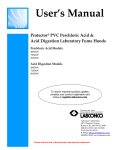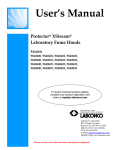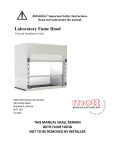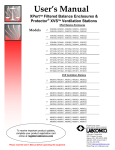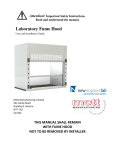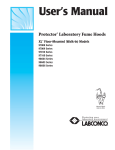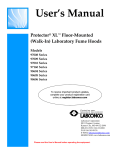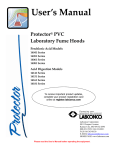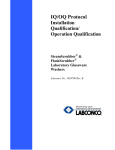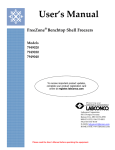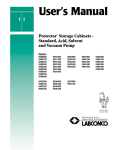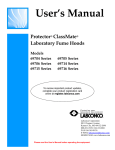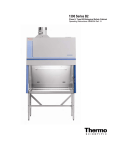Download chapter 5 using your protector demonstration hood
Transcript
Protector® Demonstration Hoods Models 3944300, 3944301 3945000, 3945001 3945020, 3945021 For more information, please contact us: ExpotechUSA 10700 Rockley Road Houston, Texas 77099 USA 281-496-0900 [voice] 281-496-0400 [fax] E-mail: [email protected] Website: www.ExpotechUSA.com The information contained in this manual and the accompanying product is copyrighted and all rights are reserved by Labconco Corporation. Labconco Corporation reserves the right to make periodic design changes without obligation to notify any person or entity of such change. Protector® Demonstration Hood Warranty Labconco provides a warranty on all parts and factory workmanship. The warranty includes areas of defective material and workmanship, provided such defect results from normal and proper use of the equipment. The warranty for all Labconco products will expire one year from date of installation or two years from date of shipment from Labconco, whichever is sooner, except the following: • • • • Purifier® Delta® Series Biological Safety Cabinets and PuriCare® Procedure Stations carry a three-year warranty from date of installation or four years from date of shipment from Labconco, whichever is sooner. FlaskScrubber®, SteamScubber and FlaskScrubber Vantage® Series Glassware Washers carry a two-year warranty from date of installation or three-years from date of shipment from Labconco. Carts carry a lifetime warranty. Glass is not warranted from breakage due to accident or mishandling. This limited warranty covers parts and labor, but not transportation and insurance charges. In the event of a warranty claim, contact Labconco Corporation or the dealer who sold you the product. If the cause is determined to be a manufacturing fault, the dealer or Labconco Corporation will repair or replace all defective parts to restore the unit to operation. Under no circumstances shall Labconco Corporation be liable for indirect, consequential, or special damages of any kind. This statement may be altered by a specific published amendment. No individual has authorization to alter the provisions of this warranty policy or its amendments. Lamps and filters are not covered by this warranty. Damage due to corrosion or accidental breakage is not covered. Limitation of Liability The disposal and/or emission of substances used in connection with this equipment may be governed by various federal, state, or local regulations. All users of this equipment are required to become familiar with any regulations that apply in the user’s area concerning the dumping of waste materials in or upon water, land, or air and to comply with such regulations. Labconco Corporation is held harmless with respect to user’s compliance with such regulations. . Part #3943400 Rev ECO C399 TABLE OF CONTENTS CHAPTER 1: INTRODUCTION About This Manual Typographical Conventions 1 2 3 CHAPTER 2: PREREQUISITES Support Requirements Location and Air Current Requirements Exhaust and Blower Requirements Electrical Requirements Space Requirements 4 5 5 5 6 6 CHAPTER 3: GETTING STARTED Unpacking the Hood Installing the Hood on a Supporting Structure & Work Surface Connecting to the Exhaust System Connecting the Electrical Supply Sealing to the Work Surface Validating the Hood 7 8 8 10 16 16 16 CHAPTER 4: HIGH PERFORMANCE FEATURES AND SAFETY PRECAUTIONS High Performance Features Safety Precautions 17 17 22 CHAPTER 5: USING YOUR PROTECTOR DEMONSTRATION HOOD 24 CHAPTER 6: MAINTAINING YOUR PROTECTOR DEMONSTRATION HOOD Routine Maintenance Schedule Calibration and Operation of Airflow Monitors Guardian Jr. Airflow Monitor Guardian Jr. Component Identification Guardian Jr. Installation Procedure 26 26 27 27 28 29 Guardian Jr. Calibration Procedure Guardian Jr. Alarm Activation Guardian Jr. Alarm Test Guardian Digital 1000 Airflow Monitor Operation Guardian Digital 1000 Alarm Installation Procedure Guardian Digital 1000 Alarm Calibration 31 33 33 33 33 35 CHAPTER 7: ACCESSORIZING YOUR PROTECTOR DEMONSTRATION HOOD Work Surfaces Guardian Digital 1000 and Guardian Jr. Airflow Monitors Fluorescent Light Exhaust Transition Adapters Remote Blowers Exhaust Dampers FilterMate Portable Exhausters and Filters Storage Cabinets Mobile Cart 8026000 Hose, Hose Clamps and Hose Kits 37 39 39 39 40 40 41 41 42 43 43 CHAPTER 8: TROUBLESHOOTING 44 APPENDIX A: REPLACEMENT PARTS 46 APPENDIX B: DIMENSIONS 50 APPENDIX C: SPECIFICATIONS 53 APPENDIX D: REFERENCES 56 DECLARATION OF CONFORMITY 59 CHAPTER 1 INTRODUCTION Congratulations on your purchase of a Protector® Demonstration Hood. Your high performance enclosure is designed to protect you by providing superior containment while conserving energy at OSHA approved “low flow” velocities as low as 60 feet per minute. It is the result of Labconco’s more than 50 years experience in manufacturing fume hoods. The Protector Demonstration Hood has been engineered to provide maximum containment. It will effectively contain toxic, noxious, or other harmful materials when properly installed. The Protector Demonstration Hood offers many unique features to enhance safety, performance, and energy savings. To take full advantage of them, please acquaint yourself with this manual and keep it handy for future reference. If you are unfamiliar with how the Protector Demonstration Hood operates, please review Chapter 4: High Performance Features and Safety Precautions before you begin working in the hood. Even if you are an experienced user, please review Chapter 5: Using Your Demonstration Hood, which describes the features so that you can use the hood efficiently. 1 Chapter 1: Introduction About This Manual This manual is designed to help you learn how to install, use, and maintain your hood. Instructions for installing optional equipment on your hood are also included. Chapter 1: Introduction provides a brief overview of the hood, explains the organization of the manual, and defines the typographical conventions used in the manual. Chapter 2: Prerequisites explains what you need to do to prepare your site before you install the hood. Electrical and service requirements are discussed. Chapter 3: Getting Started contains the information you need to properly unpack, inspect, install, and certify the hood. Chapter 4: High Performance Features and Safety Precautions explains how the Protector Demonstration Hood operates and the appropriate precautions you should take when using the hood. Chapter 5: Using Your Protector Demonstration Hood discusses the basic operation of how to prepare, use and shut down your hood. Chapter 6: Maintaining Your Protector Demonstration Hood explains how to perform routine maintenance on the hood. Chapter 7: Accessorizing Your Protector Demonstration Hood explains acceptable modifications to the hood or how to add accessories. Chapter 8: Troubleshooting contains a table of problems you may encounter while using the hood including the probable causes of the problems and suggested corrective actions. 2 Chapter 1: Introduction Appendix A: Components contains labeled diagrams of all of the components of the Protector Demonstration Hoods. Appendix B: Dimensions contains comprehensive diagrams showing all of the dimensions for the hoods. Appendix C: Specifications contains the electrical requirements for Protector Demonstration Hoods. Wiring diagrams are also included. Appendix D: References lists the various resources available that address laboratory ventilation. Typographical Conventions Recognizing the following typographical conventions will help you understand and use this manual: • • • • • • Book, chapter, and section titles are shown in italic type (e.g., Chapter 3: Getting Started). Steps required to perform a task are presented in a numbered format. Comments located in the margins provide suggestions, reminders, and references. Critical information is presented in boldface type in paragraphs that are preceded by the exclamation icon. Failure to comply with the information following an exclamation icon may result in injury to the user or permanent damage to the enclosure. Critical information is presented in boldface type in paragraphs that are preceded by the wrench icon. A trained certifier or contractor should only perform these operations. Failure to comply with the information following a wrench icon may result in injury to the user or permanent damage to your hood. Important information is presented in capitalized type in paragraphs that are preceded by the pointer icon. It is imperative that the information contained in these paragraphs be thoroughly read and understood by the user. ! ☞ 3 CHAPTER 2 PREREQUISITES Before you install the Protector Demonstration Hood, you need to prepare your site for installation. Carefully examine the location where you intend to install the hood. You must be certain that the area is level and of solid construction. In addition, a dedicated source of electrical power should be located near the installation site to power the accessory FilterMate Portable Exhauster or other apparatus. Carefully read this chapter to learn the requirements for your installation site: • • • • • The support requirements. The location and air current requirements. The exhaust and blower requirements. The electrical power requirements. The space requirements. Refer to Appendix B: Dimensions for complete Protector Demonstration Hood dimensions. Refer to Appendix C: Specifications for complete electrical and environmental conditions, specifications and requirements. 4 Chapter 2: Prerequisites Support Requirements At a minimum, the supporting structure usually consists of a base cabinet, or a base stand and chemically-resistant work surface. When setting up a chemical station, a mobile stand or cart is allowable. Labconco manufactures a mobile cart with work surface specifically designed to support the Protector Demonstration Hood and FilterMate Portable Exhauster. The cart is supplied with the Mobile Protector Demonstration Hood or can be ordered separately as an accessory. See Chapter 7 for accessories. Location and Air Current Requirements The Protector Demonstration Hood has been designed to contain hazards by negating typical cross drafts and movements within the opening. As a precautionary measure it is recommended that the enclosure be placed in such an area away from: • • • High traffic areas where walking might cause an air disturbance. Overhead or wall HVAC diffusers, fans, radiators or other lab equipment producing air currents. Next to doorways or windows that may be opened. Exhaust and Blower Requirements The exhaust connection has been designed to accept a 2" x 10" (5.1cm x 25.4cm) nominal exhaust collar. The Protector Demonstration Hood has two possible exhaust connections with either the top exhaust open and the bottom exhaust closed or vice versa. The bottom exhaust connection is primarily used in installations where the hose or ductwork will be concealed. The bottom exhaust is used on the Mobile Protector Demonstration Hood to conceal the exhaust and facilitate connection to the FilterMate Portable Exhauster. Labconco offers accessory Transition Adapters for the top or bottom exhaust connection to either a 5" hose or 6" duct. (See Chapter 7 for ordering any of these accessories). Only one exhaust connection is required. The mobile Protector Demonstration Hood includes the lower 5" hose exhaust transition, FilterMate Portable Exhauster, 5" hose, mobile cart and work surface. Data for the exhaust volume and enclosure 5 Chapter 2: Prerequisites static pressure loss are listed for each model at face velocities of 60, 80 and 100 fpm. Demo Hood Width 3' Demo Hood Height 22.75" 3' 32" Model Description Demonstration Hood w/ 8" sash opening Demonstration Hood w/ 10" sash opening Face Velocity (fpm) 60 80 100 60 80 100 Exhaust Volume (CFM) 110 145 185 140 185 230 Static Pressure Loss (in w.g..) .04" .06" .10" .06" .10" .15" Proper blower selection can be determined from these exhaust requirements and the total system static pressure loss. The enclosure must be connected to either a dedicated blower, a house exhaust system or a dedicated filtered exhauster, such as a Labconco FilterMate Portable Exhauster. Labconco offers three accessory remote blowers listed in Chapter 7. Electrical Requirements Standard duplex electrical receptacles should be nearby for connecting the Demonstration Hood, FilterMate Portable Exhauster, an airflow monitor, accessory Fluorescent Light or other equipment. For your convenience both the accessory FilterMate and accessory fluorescent light kit have auxiliary outlet receptacles. It is required that the airflow monitor be connected directly to the auxiliary switched outlet on the rear of the FilterMate so the airflow monitor is ON when the blower is ON. The FilterMate auxiliary switched outlet is rated for 8 amps. For other blower exhaust systems, it is recommended that the airflow monitor be switched by the same circuit as the exhaust blower. If this is not possible, then the airflow monitor may be connected to the switched auxiliary outlet on the accessory fluorescent light kit. The fluorescent light kit auxiliary outlet can be used for any accessory under 8 amps. Space Requirements The dimensions for the different models are shown in Appendix B: Dimensions. 6 CHAPTER 3 GETTING STARTED Now that the site for your Protector Demonstration Hood is properly prepared, you are ready to unpack, inspect, install, and validate your hood system. Read this chapter to learn how to: • Unpack and move the hood. • Set up the hood with the proper supporting structure and work surface. • Connect to an exhaust system. • Connect the electrical supply. • Seal the hood to the work surface. • Arrange validation for the enclosure. Depending upon which model you are installing, you may need common plumbing and electrical installation tools in addition to wrenches, ratchets, sockets, a nut driver set, a flat-blade screwdriver, a Phillips screwdriver, and a carpenter level to complete the instructions in the chapter. ! The hoods weigh either 100 or 120 lbs. each (45 to 54 kg). The shipping container allows for lifting with a mechanical lift truck or floor jack. If you must lift the hood manually, follow safelifting guidelines. Do not lift by the front air foil. 7 Chapter 3: Getting Started Unpacking the Hood The United States Interstate Commerce Commission rules require that claims be filed with the delivery carrier within fifteen (15) days of delivery. Carefully remove the shrink-wrap or carton on the hood and inspect it for damage that may have occurred in transit. If damaged, notify the delivery carrier immediately and retain the entire shipment intact for inspection by the carrier. ☞ DO NOT RETURN GOODS WITHOUT THE PRIOR AUTHORIZATION OF LABCONCO. UNAUTHORIZED RETURNS WILL NOT BE ACCEPTED. ☞ IF ENCLOSURE WAS DAMAGED IN TRANSIT, YOU MUST FILE A CLAIM DIRECTLY WITH THE FREIGHT CARRIER. LABCONCO CORPORATION AND ITS DEALERS ARE NOT RESPONSIBLE FOR SHIPPING DAMAGES. Do not discard the packing material until you have checked all of the components and tested the unit. We recommend that you do not remove the hood from its shipping container until it is ready to be placed into its final location. Move the unit by placing a flat, low dolly under the shipping skid, or by using a floor jack. ! Do not move the hood by tilting it onto a hand truck. Installing the Hood on a Supporting Structure and Work Surface When installing the hood onto a chemically resistant work surface or benchtop, ensure that the structure can safely support the combined weight of the hood and any related equipment. The work surface should be at least as wide as the hood to properly support it. The front of the hood should be aligned within 1/8" of the front of the work surface. Mounting holes are provided in Labconco accessory work surfaces to secure the hood. The mobile Demonstration Hood features a work surface attached to the cart. 8 Chapter 3: Getting Started Work Surface Specifications The work surface should be smooth, rigid, and durable, such as a chemically resistant epoxy resin. The surface should be nonporous and resistant to the acids, solvents and chemicals used in conjunction with the Protector Demonstration Hood. The work surface should also contain a dished recessed area for containing primary spills. Work Surface and Hood Installation 1. Level the base cabinets and the work surface. Work surface should be placed flush with the front of the base cabinet as shown in Figure 3-1. 2. Position the work surface in its intended location and with the front of the work surface (wide flange) towards you. 3. Secure the work surface to the base cabinet with a structural adhesive or silicone sealant. 4. Insert the supplied mounting screws in the four holes. Allow a minimum of 1/8" clearance under the head of the screw for positioning the enclosure. 5. Place the hood on the work surface and slide the rear flange and front air foil flanges under the mounting screw heads. 6. Tighten the four screws to complete the installation. Side View of Typical Installation Figure 3-1 9 Chapter 3: Getting Started Connecting to the Exhaust System ! WARNING: The weight of the exhaust ductwork system must be supported independently of the superstructure or damage may occur. The exhaust system should be installed by a qualified HVAC contractor. The exhaust connection on the Demonstration Hood has been designed to accept a 2" x 10" (5.1cm x 25.4cm) nominal transition adapter. See Chapter 7 for ordering accessory transition adapters. Labconco manufactures transition adapters for either top or bottom exhaust and for both 5" dia. hose or 6" dia. duct. Review Chapter 2 for remote blower and FilterMate Portable Exhauster exhaust prerequisites and review Chapter 7 for ordering blower exhaust equipment. For your convenience several exhaust options are shown in Figures 3-2, 33, 3-4, 3-5 and 3-6. Consult Labconco Customer Service should you require help sizing your blower for the exhaust volume and system static pressure loss. 10 Chapter 3: Getting Started 6.03" ID Exhaust Transition Adapter Figure 3-2 Top Connection to Outside Exhaust 11 Chapter 3: Getting Started To Outside Exhaust Figure 3-3 Side View of Bottom Connection to Outside 12 Chapter 3: Getting Started Exhaust Transition Adapter Accessory Fluorescent Light Accessory Airflow Monitor 5" ID Hose included with FilterMate FilterMate Portable Exhauster Figure 3-4 Top Connection to FilterMate Portable Exhauster 13 Chapter 3: Getting Started To Outside Exhaust Via Thimble Connection (6" nominal) Figure 3-5 Bottom Connection to FilterMate With Outside Thimble Exhaust Connection 14 Chapter 3: Getting Started Accessory Fluorescent Light Accessory Airflow Monitor FilterMate Portable Exhauster Back of Demonstration Hood Lower 5" ID Hose Exhaust Transition Adapter Back of FilterMate Portable Exhauster Figure 3-6 Connection to FilterMate on Mobile Cart 15 Chapter 3: Getting Started Connecting the Electrical Supply A standard duplex receptacle should be nearby for connecting the FilterMate Portable Exhauster, airflow monitor and accessories. Please review Chapter 2 for electrical prerequisites. All wiring for the building duplex outlets SHOULD be performed by a licensed electrician and conform to all local codes. Sealing to the Work Surface When the hood has been set in place, ducted and wired, it may be sealed at the work surface to prevent spilled materials from collecting under the walls. A bead of silicone sealant is recommended to seal the hood to the work surface. Validating the Hood The exhaust damper, exhaust blower or FilterMate gives you the flexibility to change the airflow at the sash opening of your enclosure. Determine the actual face velocity at the sash opening by taking airflow velocity readings. These should be taken across the sash opening of the enclosure in accordance with the Industrial Ventilation Manual. (See Appendix D) The “average face velocity” is achieved by taking readings in two rows across the enclosure with the readings 6" from the ends and evenly spaced every 12"; the first row is 3" down from the upper sash foil and the second row is 3" up from the work surface. Labconco recommends an average face velocity at the sash opening of 60 to 100 feet per minute for Protector Demonstration Hoods. Refer to Chapter 2 for proper airflow volumes for your particular model. Your Protector Demonstration Hood has been tested at the factory per ASHRAE 110-1995. All enclosures achieve an “as manufactured rating” of less than 0.05 part per million (ppm) at 4 liters per minute (lpm); AM <0.05 (Consult Labconco for individual ratings). For “field use” ASHRAE testing contact Labconco for a certified on-site contractor. ! 16 NOTE: Face velocity profiles and smoke testing should be performed frequently per your organization’s quality system to ensure safe performance. CHAPTER 4 HIGH PERFORMANCE FEATURES AND SAFETY PRECAUTIONS High Performance Features: The patented (U.S. Patent No. 6,461,233) Protector Demonstration Hood is designed to meet the needs of a variety of laboratory applications, and provide superior containment while conserving energy at OSHA approved “low flow” velocities as low as 60 feet per minute. The Protector Demonstration Hood has been designed to effectively contain toxic, noxious, or other harmful materials when properly installed and operated. What makes the Protector Demonstration Hood so unique is the revolutionary way it directs air into and through the contaminated air chamber. Labconco engineered the hood to minimize the effects of turbulence. The containment enhancing and aerodynamic designs of the upper sash foil, side air foils, lower air foil, upper dilution air supply, and rear baffle all work in concert to produce airflow patterns that significantly reduce both powder and chemical concentrations through the work area. The Protector Demonstration Hood incorporates unique 360° visibility, which is useful in laboratory demonstrations and visibility across classrooms. 17 Chapter 4: High Performance Features and Safety 14 3 12 6 13 9 2 8 5 4 1 10 7 16 Figure 4-1 18 Chapter 4: High Performance Features and Safety 1. Aerodynamic Clean-Sweep™ Air Foil has a unique low profile shape that allows air to sweep the work surface for maximum containment. The Clean-Sweep™ openings create a constant protective barrier from contaminants. In addition, should the operator inadvertently block the airflow entering the air foil, air continues to pass under the air foil and through the Clean-Sweep openings. See Figure 4-2. Figure 4-2 2. Containment-Enhancing Upper Sash Foil includes a perforated air passage directly atop the sash foil to bleed air into the hood chamber and direct chemical and powder concentrations away from the sash opening. The radiused sash foil sweeps airflow into the hood with minimal turbulence. See Figure 4-3. Figure 4-3 19 Chapter 4: High Performance Features and Safety 3. Upper Dilution Air Supply provides bypass air from above the work area. This feature constantly bathes the sash interior with clean air and reduces powders and chemical fumes along the sash plane, near the critical breathing zone. Five to seven percent of the required air volume is introduced through the upper dilution air supply to ensure maximum containment. Additionally, the upper dilution air supply reduces stagnant pockets of air in the upper interior. See Figure 4-4. Figure 4-4 4. Visible Clear Rear Baffle directs air streams to the baffle in a single pass. The baffle and rear panel are manufactured from framed glass panels to provide maximum visibility on all sides. This smooth flow minimizes the potential for air to roll forward preventing contamination from moving toward the sash opening. The concentrations of materials are largely removed on the first pass through the contaminated chamber. 5. Side Entry Air Foils allow turbulence-free air to enter the hood from the sides and allow clean air to sweep the interior walls. 6. Ergonomic Slope provides maximum visibility, and comfort reduces glare, thereby minimizing operator fatigue. 20 Chapter 4: High Performance Features and Safety 7. Internal Depth of 23" provides necessary space to support equipment without extending outside the hood or resting on the lower air foil. 8. Two Heights available as standard enclosures in 22.75" or 32". Taller height Demonstration Hoods are typically used for pipet operations, titration or taller auxiliary equipment. 9. Unique Flush Sash with Spring-Loaded Latch has a wiping seal to contain contaminants and features a springloaded latch for loading auxiliary equipment. The sash pivots down for normal operation. 10. Electrical Pass through Iris allows electrical cords and data cords to pass through the back of hood without leaving a large hole for contaminants to escape. The hood ships with solid plugs and the iris plugs are included with the instruction manual for your convenience. 11. Shipped fully assembled to eliminate the need for costly onsite assembly. Accessories such as the exhaust transition connections, work surfaces, airflow monitors and fluorescent light kits are easily installed. 12. Accessory Exhaust Connections. The Protector Demonstration Hoods feature two exhaust locations: One is located on the top of the rear plenum and the other is located on the bottom of the rear plenum. The bottom exhaust incorporates a tissue screen to prevent debris from clogging the exhaust blower. Exhaust transition connectors are available for either a 6" OD outside exhaust or a 5" ID hose. All exhaust transition connectors are illustrated in Chapters 2 and 3 and accessories listed in Chapter 7. The lower 5" ID hose exhaust connection is used with the mobile cart for connection to the FilterMate Portable Exhauster which rests on the lower shelf. 13. Accessory Guardian™ Airflow Monitor or Guardian Jr. Monitor continuously monitors airflow. An audio/visual alarm alerts the user to low airflow conditions. The Guardian™ 1000 Digital Airflow Monitor also displays a face velocity value, provides an RS232 output, a night setback mode and several auxiliary relay ports. See Chapter 7 for ordering information. 14. Accessory Fluorescent Light Kits provide excellent illumination with an auxiliary outlet plug for supplying power to auxiliary equipment such as a balance or printer. See Chapter 7 for ordering information. 21 Chapter 4: High Performance Features and Safety 15. Accessory Roof-Mounted Blower sized to provide adequate airflow to Protector Demonstration Hoods when used with an exhaust damper. See Chapters 2, 3 and 7. 16. Accessory FilterMate Portable Exhauster provides up to 280 cfm for HEPA or Carbon filtration or up to 220 cfm for combination HEPA/Carbon filtration when connected to the hood. See Chapters 2, 3 and 7. 17. Mobile Demonstration Hood includes FilterMate Portable Exhauster, Demonstration Hood, work surface and mobile cart to allow easy transport throughout the facility. See Figure 3-6. Mobile cart can be ordered separately as shown in Chapter 7. Safety Precautions ! ! ! Although the hood has been engineered to maintain optimum operator safety, caution should always be used while working. Prior to using the hood, check to make sure that the exhaust blower is operating and that air is entering the hood at its specified face velocity. The use of an airflow monitor is recommended to alert the user if there is a problem with airflow. Use good housekeeping in the hood at all times. Clean up spills immediately. Periodically clean enclosure interior. Do not overload the work surface with apparatus or work material. The safe operation of the hood is based upon having proper airflow through the structure. Do not place large, bulky objects such as block heaters, directly on the work surface. Instead, elevate the object 3/4" on blocks to allow a flow of air under the object and into the rear baffle exhaust slots. Ensure blocks are level and secured in place. Blocking large portions of the rear baffle will change the airflow pattern in the hood causing turbulence. (Do not store containers 22 Chapter 4: High Performance Features and Safety or supplies against the rear baffle, as this will affect airflow). Always work with your hands as far back in the hood as possible. It is best to keep all powders, chemicals and apparatus inside the lower air foil of the hood. ! Do not work with chemicals in this hood without the exhaust system running. Perchloric acid use in this hood is prohibited. ! High-level radioisotope materials are prohibited in this hood. Avoid cross drafts and limit traffic in front of the hood. Air disturbances created may draw contaminants out of the hood. The hood should be tested by a qualified certification technician before it is initially used. The hood should be validated whenever it is relocated, serviced or at least annually thereafter. The use of safety goggles, protective clothing, gloves and any other personal protective equipment recommended by your safety officer should be used. The sash should remain in the down position while using the hood. Proper operation of the hood depends largely upon its location and the operator’s work habits. Consult the references in Appendix D. 23 CHAPTER 5 USING YOUR PROTECTOR DEMONSTRATION HOOD Planning • Thoroughly understand procedures and equipment required before beginning work. • Arrange for minimal disruptions, such as room traffic or entry into the room while the hood is in use. Start-up • Turn on exhaust system and accessory light if so equipped. • Only raise the sash for loading. • Check the baffle air slots for obstructions. • Allow the enclosure to operate unobstructed for 1 minute. • Wear a long sleeved lab coat and rubber gloves. Use protective eyewear. Wear a protective mask if appropriate. Consult your Safety Officer for additional personal protective equipment recommendations. Loading Materials and Equipment • Only load the materials required for the procedure. Do not overload the hood. • Do not obstruct the air foil, or rear baffle slots. • Large objects should not be placed close together and should be elevated above the work surface to permit airflow to sweep under the equipment. 24 Chapter 5: Using Your Protector Demonstration Hood Work Techniques • Keep all materials inside the lower air foil, and perform all contaminated operations as far to the rear of the work area as possible. • Segregate all clean and contaminated materials in the work area. • Avoid using techniques or procedures that disrupt the airflow patterns of the hood. Final Purging • Upon completion of work, the hood should be allowed to operate for two to three minutes undisturbed, to purge airborne contaminants from the work area before shutting down the blower. Unloading Materials and Equipment • Objects in contact with contaminated material should be surface decontaminated before removal from the hood. • All open trays, weigh vessels or chemical containers should be covered before being removed from the hood. Shutdown • Turn off the exhaust system and accessory light if provided. 25 CHAPTER 6 MAINTAINING YOUR PROTECTOR DEMONSTRATION HOOD Now that you have an understanding of how to work in the hood, we will review the suggested maintenance schedule and the common service operations necessary to maintain your hood for peak performance. ! Only trained and experienced certification technicians should perform some of the service operations after the hood has been properly decontaminated. DO NOT attempt to perform these operations if you are not properly trained. The wrench icon precedes the service operations that require qualified technicians. Routine Maintenance Schedule Weekly • Clean the hood interior appropriate for the application. • Operate the exhaust system, noting the airflow velocity through the enclosure using a source of visible smoke. Airflow alarms are recommended for constant monitoring. 26 Chapter 6: Maintaining Your Protector Demonstration Hood Monthly (or more often as required) • Determine the actual face velocity through the sash opening of the hood where the average reading should be at the specified velocity. (Use calibrated thermal anemometer or other approved apparatus). Airflow alarms are recommended for constant monitoring. • Using a cloth and glass cleaner, clean the exterior surfaces of the hood, particularly the front of the hood, to remove any accumulated dust. • The hood rear baffle should be checked for any blockage to ensure that the enclosure is maintaining proper airflow. • All weekly activities. Annually • Have the hood validated by a qualified certification technician. See Validating the Hood in Chapter 3. • All monthly activities. Calibration and Operation of Airflow Monitors Guardian Jr. Airflow Monitor The Guardian Jr. Airflow Monitor is designed to continuously monitor airflow through hoods. This permanently installed device provides both visual and audible alarms to alert the user of abnormal airflow conditions. A green light on the front of the monitor indicates normal flow conditions. When flow conditions lower than the set point are encountered, a red light is activated along with an audible alarm. A test button is provided at the front of the monitor to allow the user to check the operation of the alarm. To temporarily mute the audible alarm, press and release the test/reset button. 27 Chapter 6: Maintaining Your Protector Demonstration Hood Guardian Jr. Component Identification 1. Air Inlet A portion of the air coming into the hood passes through the air inlet and across the flow sensors. 2. Normal Flow Indicator This green light indicates normal flow conditions. 3. Alarm Indicator This red light is activated approximately 6 seconds after the low flow set point is reached. 4. Test/Reset Button If no alarm is present, this button will cause the red lamp to light and the audible alarm to sound. If an alarm is present, the button will silence the audible alarm. 5. Adjustment for Alarm Set Point This potentiometer is used to set the low flow indicators for the alarm. It is adjusted with a small screwdriver. 1 3 2 4 5 Figure 6-1 Guardian Jr. Components 28 Chapter 6: Maintaining Your Protector Demonstration Hood Guardian Jr. Installation Procedure 1. The hood comes prepared to except the Guardian™ Jr. airflow monitor system. 2. First remove the small 0.50" dia. gray hole plug and two #8-32 x 0.50" self-tapping Phillips screws from the hood. Keep the screws for step 5. See Figure 6-2. See Figure 6-3 for steps 3 through 9. 3. Open the top monitor cover by removing the two #8-32 x .38" lg. Phillips screws to access the tube stem and clear plastic tubing. 4. Temporarily remove the tube stem, Item 1 in Figure 6-3, and clear plastic tubing, Item 2. 5. Without the tube stem and clear plastic tubing attached, mount the Guardian Jr. alarm module to the hood with the two #8-32 x 0.50” screws removed in step 2. 6. Install the tube stem by tapping the non-serrated end of the tube stem into the 0.50" hole on the enclosure. Silicone sealant may be applied between the tube stem and the hood. 7. Route the clear plastic tubing without kinks between the rubber elbow tubing connector on the back of the Guardian Jr. alarm module and the tube stem. This completes the airway passage between the alarm module and the hood. 8. Locate the 9VDC power supply transformer, which should already be connected to the back of the alarm module through the strain relief bushing. If disconnected, then reconnect to the airflow monitor. Plug the 9VDC power supply into a 115V duplex receptacle, the back of the accessory FilterMate Portable Exhauster or the back of the accessory fluorescent light. For 230V, plug the power supply into an adapter or add an extension cable for connection to the FilterMate. It is recommended that the airflow monitor be connected directly to the FilterMate switched auxiliary outlet so the airflow monitor is powered at the same time. 9. Finish the installation by re-attaching the top monitor cover with two #8-32 x .38" lg. Phillips screws from step 3. 29 Chapter 6: Maintaining Your Protector Demonstration Hood #8-32 x .50" Self-Tapping Phillips Screws Small 0.50" Dia. Hole Plug Large 1.19" Dia. Hole Plug Figure 6-2 Hole Plug Location & Mounting Screws Cover Airflow Monitor Rubber Elbow Clear Plastic Tubing Item #2 Tube Stem Item #1 Figure 6-3 Guardian Jr. Details 30 Chapter 6: Maintaining Your Protector Demonstration Hood Guardian Jr. Calibration Procedure Each Guardian Jr., alarm module and hood is unique and needs to be individually calibrated in the field. The procedure for the adjustment is as follows: 1. Double check the installation instructions to make sure that monitor and power supply are properly installed. 2. Allow 10 minutes for the monitor to warm up once power has been connected. 3. Determine the low flow set point for your monitor. This is the value where the monitor will first indicate a low flow condition. The red light will be on for this value. Refer to your industrial hygiene officer for the proper low flow set point or consult the table to follow. 4. Adjust your hood airflow to the low flow set point as previously determined. The exhaust flow can be lowered by adjusting the speed control on the FilterMate or by using an adjustable damper on the exhaust blower. Typical alarm conditions are set at face velocities of 10 to 20 feet per minute below the normal operating conditions due to supply air and exhaust air fluctuations, as well as room air cross drafts. 5. Using a properly calibrated thermoanemometer, determine the velocity through the face of the hood by taking a detailed velocity traverse. Divide the face area into equal increments. One reading per square foot of face area is normally recommended for an accurate traverse. Compute the average velocity for this area. 6. If the red light alarm is on, slowly turn the adjustment screw counterclockwise until the green light is activated. If the green light is on, slowly turn the adjustment screw clockwise until the red light comes on. Slowly turn the adjustment screw back until the red light is activated. It is important that these adjustments be done in small increments, at intervals about 10 seconds apart to allow for delayed reaction of the alarm itself. The alarm low flow set point should now be set and the red light activated. 7. Readjust the hood airflow to its normal operating levels. The green light should now be activated. 8. Calibration is now complete. 31 Chapter 6: Maintaining Your Protector Demonstration Hood Enclosure Operating In Flow Speed 100 fpm 80 fpm 60 fpm Alarm Condition Set Point Speed 80 - 90 fpm 60 - 70 fpm 40 - 50 fpm Accessory Light Airflow Monitor Installed Enclosure Figure 6-4 Guardian Jr., Installed 32 Chapter 6: Maintaining Your Protector Demonstration Hood Guardian Jr. Alarm Activation The audio and visual alarm will activate approximately six seconds after an alarm condition is detected. To temporarily mute the audible alarm, press and release the test/reset button. NOTE: After an alarm condition has been detected, the red light will stay on. The audible alarm will remain muted until airflow returns to normal levels. Guardian Jr. Alarm Test When no alarm is present the alarm can be tested by pressing the test/reset button. While the button is pressed, the alarm light and audible alarm will be activated. Guardian Digital 1000 Airflow Monitor Operation The Guardian Digital Airflow Monitor consists of the airflow sensor, the alarm and the 15 VDC power supply. For 115V operation the alarm unit is powered by plugging the power supply into the factory-prepared digital airflow monitor socket. For 230V operation, the alarm is powered by plugging the power supply into a building outlet. The alarm has “Enter”, “+”, and “-” buttons to program the monitor. There is also a green LED “SAFE”, yellow LED “CAUTION”, and red LED “LOW” with audible alarm for airflow conditions. The audible alarm can be permanently muted if desired. The Guardian Digital 1000 Airflow Monitor displays a face velocity value, provides an RS232 communications port to a PC or building computer system, can be configured for external input connections such as night setback or external alarm and provides up to three output relays that can be configured. For complete detailed information, please refer to the separate Guardian 1000 Alarm User’s Manual provided with the enclosure. Guardian Digital 1000 Installation Procedure 1. The hood comes prepared to except the Guardian 1000 Digital Airflow Monitor. 2. First remove the large 1.19" dia. gray hole plug and two #8-32 x 0.50" self-tapping Phillips screws from the hood. Keep 33 Chapter 6: Maintaining Your Protector Demonstration Hood the screws for step 3. See Figure 6-2. See Figure 6-5 only to reference internal assembly of the airflow monitor. 3. Secure the Guardian Digital Monitor to the enclosure with the two #8-32 x 0.50" screws removed from step 2. 4. The airway passage between the alarm module and the hood is now complete. 5. Locate the 15VDC power supply transformer. One end should already be connected to the two-pin connector labeled 15 VDC on the back of the alarm module and through the strain relief bushing. If disconnected, then reconnect to power the airflow monitor. Plug the 115V power supply into a 115V duplex receptacle, the back of the accessory FilterMate Portable Exhauster or the back of the accessory fluorescent light. For 230V, plug an adapter or add an extension cable for connection to the FilterMate. It is recommended that the airflow monitor be connected directly to the FilterMate switched auxiliary outlet so the airflow monitor is powered at the same time. 6. Installation is now complete. Display Digital 1000 Monitor Airflow Sensor Figure 6-5 Guardian Digital 1000 Monitor Details 34 Chapter 6: Maintaining Your Protector Demonstration Hood Guardian Digital 1000 Calibration 1. Calibrate the airflow monitor according to the monitor User’s Manual that comes with the kit and follow the instructions below. To successfully calibrate, it will be necessary to change the face velocity by adjusting the airflow exhaust volume. The exhaust volume can be adjusted with the speed control on the FilterMate or by using an adjustable damper on the exhaust blower. Typical calibration conditions are set at face velocity air sample differences of at least 20 feet per minute. The airflow monitor is factory set to be calibrated with a difference of at least 50 fpm and can be changed by changing the “lower/higher air sample difference.” The following suggested in flow face velocity speeds are recommended to successfully calibrate. Typical low air alarms are set 10-20 fpm below operational speeds. Follow Step 2 below and review the Guardian 1000 Alarm User’s Manual that comes with the airflow monitor. Low Air Alarm Set Point 40 - 50 fpm 60 - 70 fpm 80 – 90 fpm Enclosure Operating Inflow Speed 60 fpm Low Calibration Set Point High Calibration Set Point 40 - 60 fpm 80 fpm 50 - 90 fpm 100 fpm 50 – 110 fpm 100 – 120 fpm 100 – 150 fpm 100 – 170 fpm 2. Go to SETUP menu and then CAL CONFIG MENU and change the “lower/higher air sample difference” to 20 fpm. This will allow you to successfully calibrate with values of a minimum of 20 fpm difference. 3. While in CAL CONFIG MENU, change the “sensor difference” from 10% to 3%. 4. While in CAL CONFIG MENU, adjust the red low air alarm to the desired setting such as 60 fpm. Then adjust the yellow “CAUTION or WARNING” to 63 fpm, if desired. Then adjust the “CAUTION or WARNING” air reset to 3 fpm. This sets the alarm condition. 5. To complete the CAL CONFIGURATION, be sure to enter “DONE”. 35 Chapter 6: Maintaining Your Protector Demonstration Hood 6. To start the calibration mode, use the Guardian Digital 1000 Monitor User’s Manual and enter “CALIBRATION” mode on the display from the SETUP menu. 7. Follow the instructions on the display and alter the low exhaust volume with the speed control on the FilterMate or exhaust damper. Measure the average face velocity and enter the low value on the display. Be careful not to block the opening. The low exhaust volume calibration will take about 5 seconds. 8. Now alter the high exhaust volume with the speed control on the FilterMate or exhaust damper. Measure the average face velocity and enter the high value on the display. The high value must be at least 20 fpm greater than the low value. The high exhaust volume calibration will take about 5 seconds. 9. Enter “DONE” after successfully completing the low and high calibration set points. 10. Once calibration is completed, go to “RUN” and press “ENTER”. The value should read close to the high calibration set point. 11. To lower the face velocity to the operating point, simply alter the exhaust volume with the speed control on the FilterMate or exhaust damper. Then recheck the face velocity with an anemometer to confirm the display on the digital airflow monitor. Accessory Light Demonstration Hood Airflow Monitor Installed Figure 6-6 Guardian Digital 1000 Monitor Installed on Demonstration Hood 36 CHAPTER 7 ACCESSORIZING YOUR PROTECTOR DEMONSTRATION HOOD There are several ways to accessorize the hood for your individual requirements. These include the addition of accessory work surfaces, airflow monitors, fluorescent lights, exhaust transition adapters, hoses, remote blowers, exhaust dampers, FilterMate Portable Exhausters, filters, storage cabinets and mobile carts. 37 Chapter 7: Accessorizing Your Protector Demonstration Hood Optional Equipment for the Demonstration Hood 4 3 2 5" ID Hose 1 7 8 5 – Remote Blower – Not Shown 6 – Exhaust Damper – Not Shown 9 – Mobile Cart – Not Shown Figure 7-1 38 Chapter 7: Accessorizing Your Protector Demonstration Hood 1. Work Surfaces An optional dished work surface is available to attach to the hood. Dished work surfaces are contoured to fit the dimensions of the hood to contain spills. Epoxy is chemical-resistant. Catalog # 3908402 3908405 Description Black, 4-foot wide Gray, 4-foot wide Dimensions (W x D x H) 48" x 26.66" x 1" 48" x 26.66" x 1" 2. Guardian™ Digital 1000 and Guardian™ Jr. Airflow Monitors The Guardian Digital 1000 Airflow Monitor or Guardian Jr. Airflow Monitor allows you to continuously monitor airflow through the hood. The rear exhaust plenum is factory prepared to mount either monitor. Catalog # 3908700 3908701 3908800 3908801 Description Guardian Jr. Airflow Monitor, 115V, 60 Hz Guardian Jr. Airflow Monitor, 230V, 50 Hz Guardian Digital 1000 Airflow Monitor 115V, 60 Hz Guardian Digital 1000 Airflow Monitor 230V, 50 Hz 3. Fluorescent Lights A fluorescent light, which rests on the top of the hood, is available. Catalog # 3909200 3909201 Description 18.25" W x 10.12"D x 3.00" H Light, 115V, 60 Hz 18.25" W x 10.12"D x 3.00" H Light, 230V, 50 Hz 39 Chapter 7: Accessorizing Your Protector Demonstration Hood 4. Exhaust Transition Adapters Adapter connects to the hood from either the top or the bottom of the rear plenum so the duct can be routed either up or down, respectively. The transition is available for either 5.00" ID hose or 6" OD duct. The 5.00" ID hose lower connection is included with the FilterMate supplied with the mobile cart. Catalog # 3912400 3912401 3912402 3912403 Description Upper connection, 5" Hose Upper connection, 6" Duct Lower connection, 5" Hose Lower connection, 6" Duct Material Epoxy-Coated Steel Epoxy-Coated Steel Epoxy-Coated Steel Epoxy-Coated Steel 5. Remote Blowers Has a 1/4 hp direct drive motor and corrosion-resistant phenolic coated-steel housing and wheel with blower inlet of 6.00" ID. Outlet dimensions are 4.25" x 7.38" OD. 0.0" 595 Catalog # Description 4863500 4863501 Remote Blower, 115 V, 60 Hz. 4.4 amps Remote Blower, 115/230 V, 50 Hz, 5.6/2.8 amps Explosion-Proof Remote Blower, 115 V, 60 Hz, 4.4 amps 7053501 40 CFM @ Static Pressure-Inches of H2O 0.125" 0.25" 0.50" 0.75" 0.87" 560 515 420 300 167 S.P. CFM Shipping Wt. (lbs./kg.) 35/16 35/16 40/18 Chapter 7: Accessorizing Your Protector Demonstration Hood 6. Exhaust Dampers Exhaust dampers allow an adjustment required to maintain proper airflow for roof-mounted blowers or house exhaust systems. Catalog # 3924000 4724200 Description 6" Epoxy-Coated Steel In-Line Adjustable Damper 6" PVC In-Line Adjustable Damper 7. FilterMate Portable Exhausters and Filters For filtered exhaust, Labconco offers FilterMate Portable Exhausters capable of exhausting up to 280 cfm of HEPA filtered air or up to 220 cfm of combination Dual Carbon or HEPA/Carbon filtered air when connected to the enclosure. Catalog # 3970000 3970001 3970002 3970003 3970004 3970020 3970021 3970022 3970023 3970024 Voltage Filter Exhaust Connection 115 Volt/60 Hz 115 Volt/60 Hz 115 Volt/60 Hz 115 Volt/60 Hz 115 Volt/60 Hz 230 Volt/50 Hz 230 Volt/50 Hz 230 Volt/50 Hz 230 Volt/50 Hz 230 Volt/50 Hz HEPA Carbon HEPA HEPA/Carbon Carbon/Carbon HEPA Carbon HEPA HEPA/Carbon Carbon/Carbon None None Thimble to outside None None None None Thimble to outside None None Exhaust Airflow (cfm) 280 280 280 220 220* 280 280 280 220 220* *Indicates model supplied with mobile cart with lower 5" exhaust transition included. HEPA Filter - 3707900 99.99% efficient on particles 0.3 micron. HEPA Filter Bag-In/Bag-Out Bag - 3776002 Helps contain hazardous particulate matter during filter changing operations. Carbon Filter Provides granular activated carbon or impregnated carbon. Filter Classification Organic Formaldehyde Ammonia Catalog # 3923400 3923401 3923402 x Pounds 12.0 lbs activated carbon 14.0 lbs impregnated carbon 16.0 lbs impregnated carbon 41 Chapter 7: Accessorizing Your Protector Demonstration Hood 8. Storage Cabinets Size/Description 48" 36" 30" 24" 18" 12" 48" w/Self Closing Doors 36" w/Self Closing Doors 30" w/Self Closing Doors 24" w/Self Closing Doors 24" ADA 24" ADA w/Self Closing Doors 18" ADA 12" ADA Size/Description 48" 36" 30" 24" 18" 12" 48" w/Self Closing Doors 36" w/Self Closing Doors 30" w/Self Closing Doors 24" w/Self Closing Doors 24" ADA 24" ADA w/Self Closing Doors 18" ADA 12" ADA 42 Dual Doors 9902000 9902100 9902200 9903000 9903100 9903200 - SOLVENT Right Hinge 9902300 9903300 9906000 9906200 - STANDARD BASE Dual Doors Right Hinge 9900000 9900100 9900200 9900300 9900400 9900500 9904000 - 9904100 9904200 Left Hinge 9902400 9903400 9906100 9906300 Dual Doors 9901000 9901100 9901200 - ACID Right Hinge 9901300 9901400 9905000 - Left Hinge 9901500 9901600 9905200 - - - 9905100 - 9905300 - Left Hinge 9900600 9900700 9900800 9904300 9904400 9904500 VACUUM PUMP Dual Doors Right Hinge Left Hinge 9907000 9907100 - - - Chapter 7: Accessorizing Your Protector Demonstration Hood 9. Mobile Cart 8026000 Provides a mobile cart and dished solid epoxy work surface for supporting the Protector Demonstration Hood. 10. Hoses, Hose Clamps, and Hose Kits Provides alternatives for ducting. Catalog # 4868600 1921000 3927500 3927600 1921500 Description 8 Feet of 5" ID gray flexible polypropylene hose (included with FilterMate). General purpose chemical-resistant hose suitable in pharmaceutical applications. 5" T-Bolt Hose Clamp (two included with FilterMate) 8 Feet of 5" ID clear smooth bore static dissipation hose with two hose clamps. Suitable in clean rooms or pharmaceutical applications. 8 Feet of 6" ID black thermoplastic hose with two 6.09" ID cuffs. Include two 6" hose clamps. Suitable for connection to house exhaust in pharmaceutical applications. 6" T-Bolt Hose Clamp 43 CHAPTER 8 TROUBLESHOOTING Refer to the following table if your Protector Demonstration Hood fails to operate properly. If the suggested corrective actions do not solve your problem, contact Labconco for additional assistance. 44 PROBLEM CAUSE CORRECTIVE ACTION Contaminants outside of enclosure Improper user techniques for the enclosure. See “Certifying the Hood” Chapter 3 and “Safety Precautions” Chapter 4 sections in the manual. (Ref. Appendix D) Restriction of the baffle air slots or blockage of the exhaust outlet. Remove obstruction to ensure that all air slots and the exhaust outlet are unobstructed. External factors are disrupting the hood airflow patterns or acting as a source of contamination. See “Location Requirements” Chapter 2, “Certifying the Hood” Chapter 3, and “Safety Precautions” Chapter 4 sections of this manual. (Ref. Appendix D) Hood has improper face velocity. Have hood certified and check exhaust system. Check FilterMate filters for loading. Adjust FilterMate speed control. Hood should have average face velocity of 60-100 fpm. Chapter 8: Troubleshooting PROBLEM Airflow monitor malfunction. CAUSE No power. No lights. No display. No audible alarm. Wrong alarm set point. Constant audible alarm. Continuous alarm. Monitor alarms; air way to airflow monitor sensor is blocked by insects, dust or debris. Audible disable will not stay ON CORRECTIVE ACTION Power supply is not plugged into proper voltage; plug in power supply. Verify that airflow monitor interface cables are connected. Check fuses on FilterMate or accessory light. Alarm has been temporarily silenced using “test/reset” or “enter” buttons. Airflow monitor was not properly adjusted. Repeat calibration steps outlined in the airflow monitor manual. Check airflow and calibration of airflow monitor. Check the face velocity of the enclosure as the airflow may have changed. If face velocity is correct, calibrate the airflow monitor as outlined in the User’s Manual. Lightly clean the airway with clean air. Be careful not to touch sensitive electrical components. An alarm condition must be continuously present before the audible alarm can be silenced. If flow conditions fluctuate near the alarm set point, the airflow monitor will automatically reset itself. Action should be taken to bring the hood airflow into proper operating parameters or adjust the alarm set point lower. 45 APPENDIX A REPLACEMENT PARTS The following illustrations indicate the replacement parts. 46 Appendix A: Replacement Parts Item 1A 1B 2 3A 3B 4 5 6A 6B 7A 7B 7C 7D 7E 7F 8A 8B 9A 9B 9C 9D 9E 10 11 12 13A 13B 13C 13D 14A 14B 15A 15B 15C 16A 16B 16C 17 18 19 Qty. 1 1 1 1 1 1 2.3 Ft. 1 1 1 1 1 2 1 1 1 1 1 1 2 2 2 1 1 1 1 1 1 1 1 1 2 2 2 2 2 4 1 1 1 Part Number 3906500 3926500 3906801 3906101 3926101 3907601 6913700 3907500 3907501 1927403 3906700 6916500 1893206 6916501 3925300 3905201 3925201 3907400 3907401 1932401 1912108 1909217 3905601 3905301 3913100 3912400 3912401 3912402 3912403 1934601 1936800 7868402 1912108 1889316 3915400 3915401 1889912 1595619 1595621 3941900 Description Glass, Side Short Glass, Side Tall Glass, Top 3' Glass, Sash 3' Short Glass, Sash 3' Tall Foil, Sash 3' Wiper, Sash Stop, Right Sash Stop, Left Sash Spring, Compression Sash Latch Latch Bracket Latch Sash Screw, #8-32 x .38 Phil, SS, Type F Latch Sash Tall Latch Bracket Tall Sash Assembly 3', Short Sash Assembly 3' Tall Bracket, Air Foil Right Bracket, Air Foil Left Washer, Shoulder Plastic Washer, .194 ID x .38 OD x .03 thick plastic Cap Nut #10-24 SS Air Foil 3' Header 3' Cover Plate, Exhaust (Top or Bottom) Upper Exhaust Transition 5" Hose Upper Exhaust Transition 6" Duct Lower Exhaust Transition 5" Hose Lower Exhaust Transition 6" Duct Bushing, Heyco with Flex Shutter 1.50 dia. Bushing, Heyco Closed 1.50 dia. Spacer Bushing Washer, .194 ID x .38 OD x .03 T. Plastic Screw, #10-24 x 1.00 PH. (SS) Side Air Foil, Short Side Air Foil, Tall Screw, 6-32 x .75 PH. Type F, Oval Head Hole Plug, .500 dia. Gray Hole Plug, 1.187 dia. Gray Label, Protector Demonstration Hood 47 Appendix A: Replacement Parts Item 20A 20B 20C 20D 21 22 Qty. 1 1 2 2 1 4 Part Number 3942500 3941700 1914200 1923900 3943000 8009501 Description Baffle Assy, Short Baffle Assy, Tall Captive Screw, Baffle Receptacle, Clip-on Shelf, Demo Cart Caster 4" w/ Brake Demo Cart 2 12 19 17,18 Not Shown 11 5 7 15 3 1 6 8 4 16 10 22 9 21 Figure A-1A 48 Appendix A: Replacement Parts 20 14 13 Figure A-1B 49 APPENDIX B DIMENSIONS See the following dimensions. 50 Appendix B: Dimensions Figure B-1 Protector Demonstration Hood Dimensions 51 Appendix B: Dimensions Figure B-2 Protector Mobile Demonstration Hood Dimensions 52 APPENDIX C SPECIFICATIONS Electrical Specifications 115V, 60 Hz Mobile Demonstration Hood, 10 Amps Max. 230V, 50/60 Hz Mobile Demonstration Hood, 5 Amps Max. Environmental Conditions • • • • • • • Indoor use only. Maximum altitude: 6562 feet (2000 meters). Ambient temperature range: 41° to 104°F (5° to 40°C). Maximum relative humidity: 80% for temperatures up to 88°F (31°C), decreasing linearly to 50% relative humidity at 104°F (40°C). Main supply voltage fluctuations not to exceed ±10% of the nominal voltage. Transient over-voltages according to Installation Categories II (Over-voltage Categories per IEC 1010). Temporary voltage spikes on the AC input line that may be as high as 1500V for 115V models and 2500V for 230V models are allowed. Used in an environment of Pollution degrees 2 (i.e., where normally only non-conductive atmospheres are present). Occasionally, however, a temporary conductivity caused by condensation must be expected, in accordance with IEC 664. 53 Appendix C: Specifications 54 Appendix C: Specifications 55 APPENDIX D REFERENCES Many excellent reference texts and booklets are currently available. The following is a brief listing: Laboratory Ventilation Standards Federal Register 29 CFR Part 1910 Non-mandatory recommendations from “Prudent Practices”. • Fume hoods should have a continuous monitoring device • Face velocities should be between 60-100 linear feet per minute (lfpm) • Average 2.5 linear feet of hood space per person Occupational Health and Safety U.S. Department of Labor 200 Constitution Avenue N.W. Washington, DC 20210 (202) 523-1452 www.osha.gov Industrial Ventilation-ACGIH • Fume hood face velocities between 60-100 lfpm • Maximum of 125 lfpm for radioisotope hoods • Duct velocities of 1000-2000 fpm for vapors, gasses and smoke • Stack discharge height 1.3-2.0 x building height • Well designed fume hood containment loss, <0.10 ppm Industrial Ventilation, A Manual of Recommended Practice. 24th Edition, 2001 American Conference of Governmental Industrial Hygienists 1330 Kemper Meadow drive Cincinnati, OH 45240-1634 (513) 742-2020 www.acgih.org 56 Appendix D: References ASHRAE 110-1995 Method of Testing Performance of Fume Hoods Evaluates fume hood’s containment characteristics • Three part test: Smoke generation, Face velocity profile, Tracer gas release @ 4 liters per minute • Rated As Manufactured (AM), As Installed (AI) and As Used (AU) American Society of Heating, Refrigerating, and Air Conditioning Engineers 1791 Tullie Circle N.E. Atlanta, GA 30329 (404) 636-8400 www.ashrae.org ANSI Z9.5-1993 Laboratory Standard Covers entire laboratory ventilation system. • Vertical stack discharge @ 2000-3000 fpm • New and remodeled hoods shall have a monitoring device • Ductless hoods should only be used with non-hazardous materials • Fume hood face velocities between 80 – 120 fpm American Industrial Hygiene Association 2700 Prosperity Avenue, Suite 250 Fairfax, VA 22031 (703) 849-8888 www.aiha.org SEFA 1-2002 • Fume hood face velocities based on toxicity levels of chemicals Class A – 125 to 150 fpm Class B – 80 to100 fpm Class C – 75-to 80 fpm • Test method – face velocity profile and smoke generation Scientific Equipment & Furniture Association 1028 Duchess Drive McLean, VA 22102 (703) 538-6007 www.sefalabs.com NFPA 45 – 2002 Fire Protection for Laboratories Using Chemicals • Laboratory hoods should not be relied on for explosion protection • Exhaust air from fume hoods should not be recirculated • Services should be external to the hood • Canopy hoods only for non-hazardous applications • Materials of construction should have flame spread of 25 or less • 80 to 120 fpm to prevent escape NFPA 30 – 2000 Flammable and Combustible Liquids Code • Approved cabinets may be metal or wood • Vent location on cabinets are required • Venting of cabinets not a requirement 57 Appendix D: References National Fire Protection Association 1 Batterymarch Park P.O. Box 9101 Quincy, MA 02269-9101 (800) 344-3555 www.nfpa.org General References American Conference of Governmental Industrial Hygienists. Industrial Ventilation, A Manual of Recommended Practice, Cincinnati, OH ASHRAE Standard Committee. ASHRAE Standard Atlanta: ASHRAE Publications Sales Department, 1995 British Standards Institution, Laboratory Fume Cupboards. Parts 1, 2 and 3, London: 1990 Department of Labor, Occupational Safety and Health Administration, 29 CFR Part 1910, Occupational Exposures to Hazardous Chemicals in Laboratories, Final Rule. Vol. 55, No. 21. Washington D.C.:1990 DiBerardinis. L. et al. Guides for Laboratory Design, Health and Safety Considerations. Wiley & Sons, 1987 McDermott, Henry, Handbook of Ventilation for Contaminant Control, 2nd Edition. Butterworth Publishers, 1985. Miller, Brinton M. et al. Laboratory Safety: Principles and Practices. American Society for Microbiology, Washington, D.C.: 1986 NIH Guidelines for the Laboratory Use of Chemical Carcinogens. NIH Publication No. 81-2385. Rayburn, Stephen R. The Foundation of Laboratory Safety, A Guide for the Biomedical Laboratory. Springer-Verlag, New York: 1990 Sax, N. Irving and Lewis, JR., Richard J. Rapid Guide to Hazardous Chemicals in the Workplace. Van Nostrand Reinhold, 1987. Schilt, Alfred A. Perchloric Acid and Perchlorates. The G. Frederick Smith Chemical Company, Columbus, OH: 1979. Steere, Norman. CRC Handbook of Laboratory Safety, 2nd Edition. CRC Press, 1971. 58 59 For more information, please contact us: ExpotechUSA 10700 Rockley Road Houston, Texas 77099 USA 281-496-0900 [voice] 281-496-0400 [fax] E-mail: [email protected] Website: www.ExpotechUSA.com

































































